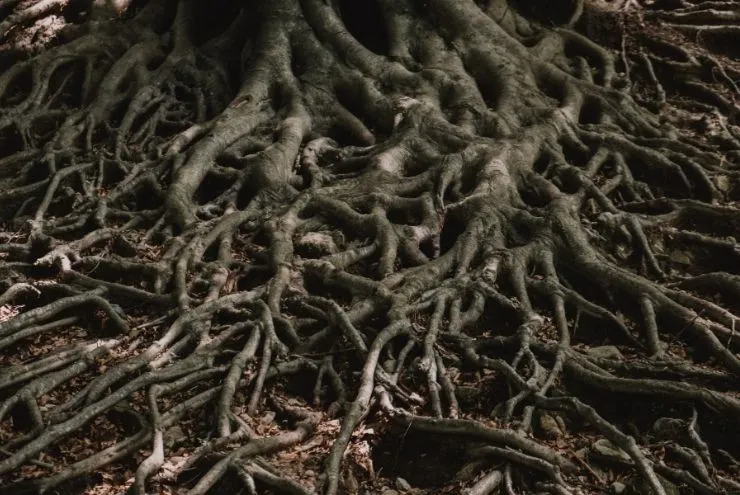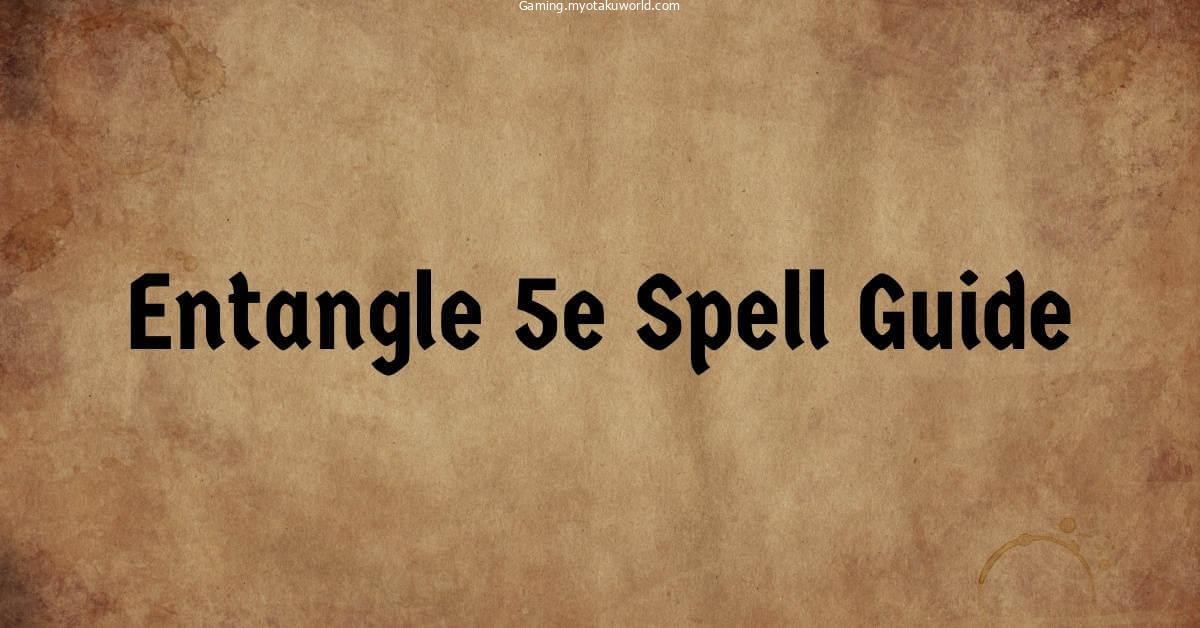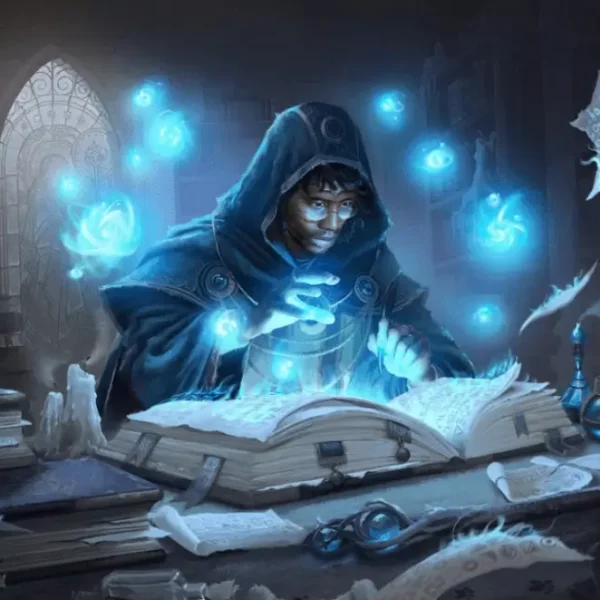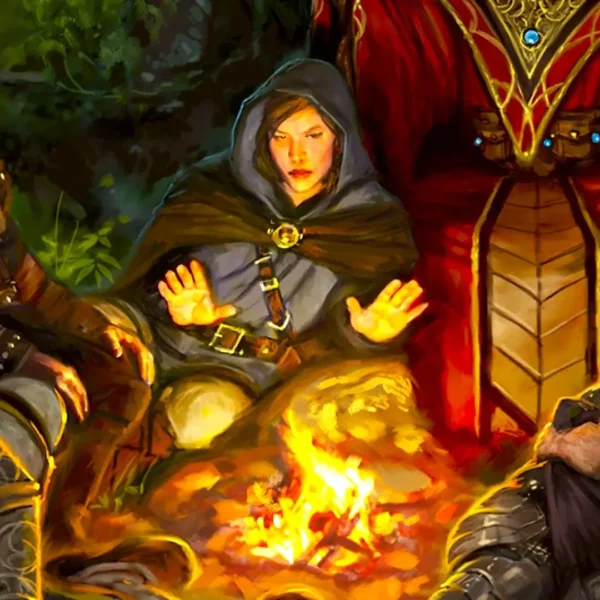Casters who are worth their salt know that powers can do more than just damage.
With the right set of spells, you can have full control over the battlefield and stop your enemies before they can hurt you or your friends.
Today, we’ll talk about the low-level spell Entangle, which helps you start doing just that.
We’ll talk about how this spell works and how you can use it to control the forces of nature on the battlefield.
Entangle
- Casting Time: 1 action
- Range: 90 ft. (20-ft. square)
- Duration: 1 minute
- School: Conjuration
- Class: Druid
- Level: 1st level
- Damage/Effect: Restrained
- Attack/Save: Strength save
- Components: V, S
Spell Description
From a point within range, weeds and plants that grab hold of things grow from the ground in a 20-foot square. For as long as these plants are there, they make the ground in the area hard to walk on.
When you cast the spell, any creature in the area must make a Strength saving throw or be held back by the plants until the spell stops.
A monster held back by the plants can use its action to make a Strength check against your spell-save DC. When it works, it sets itself free.
When the spell is over, the plants that were brought to life die.
What Is the Entangle Spell 5e?

The entangle spell is a simple focus spell that lets you stop creatures from moving and make a part of the battlefield harder.
This is a concentration spell that could last for the whole fight, but it’s pretty likely that any animals you hold back will break free before the spell ends.
When you cast this, you’ll make a square of hard ground 20 feet by 20 feet that is centered on a point 90 feet from you. That means that four 16-square areas of the battlefield will be covered with plants that will catch your enemies.
Difficult terrain is a pretty big effect that you can put on the landscape. It makes creatures move at half speed or spend 2 feet of movement for every foot they move through the space.
This kind of action can make a huge difference in how you control the battlefield. It could keep your friends safe for a few turns and let your party’s ranged attackers cast several powerful spells.
If you do it right, the difficult terrain part of this spell alone can give your friends a free round of actions.
Of course, this spell does more than just that. It can also give your enemies the restrained state, which is a pretty bad one.
When a monster is restrained, its movement speed drops to 0, it can’t get any speed bonuses, and it has disadvantage on dexterity saving throws.
Also, attacks against them have an edge, while attacks they try to make have a disadvantage.
You don’t want to be held back, but putting it on your enemies can change the way the fight goes. The only hard part about this is that the situation of being restrained is tied to a strength-saving throw.
When you first start using this skill at lower levels, strength-saving throws are one of the best things to aim for.
Most beings with a low CR have very low strength scores, so it’s likely that you’ll be able to control them. Also, it’s likely that you’ll be able to hold them back for a few turns.
Unfortunately, as you face harder creatures, their strength scores will almost certainly get higher, making it harder for you to hold them back with a spell like this.
Overall, this simple 1st-level spell has a lot to offer.
Who Should Take Entangle?
Entangle is a druid power, so it makes sense that only druids will learn it. Specifically, druids who want to focus on controlling the battlefield will use this power as well as they can.
As a spell that uses nature to hold your enemies back, it makes sense that this spell is only for druids.
Even though there are other ways to get this, like with the Magic Initiate feat or the bard’s Magical Secrets feature, other classes probably won’t be rushing to get it.
Don’t get me wrong, this spell is great, but it’s great because it works well with the druid class. Druids have the ability to be the best at controlling the battlefield.
With cards like “Gust” and “Thornwhip,” they can move creatures around the battlefield.
This means that you have the tools you need to move things where you want them to be. Once you’ve done that, you’ll be in a good situation to cast a trap that can hold back a lot of your opponents.
A Circle of the Land arctic druid has access to a lot of circle skills that work well with this type of build.
Most of these spells are for druids, but you always have them ready, so they work on top of whatever magic you’re making for the day.
As an Arctic Circle of the Land monk, you’ll have Hold Person, Spike Growth, Sleet Storm, and Slow by 5th level. All of these spells are very strong ways to take control.
Most of them require concentration, and you can only focus on one spell at a time, but it’s great to have a range of spells that give you some control over the battlefield.
The Circle of Stars is also a good choice for this kind of control play.
At 3rd level, you can use your wild shape to take on a “Starry Form,” which lets you treat rolls of 9 or less on focus saves as a 10.
If you can keep that focus for longer, it will make a huge difference.
At 6th level, this subclass also gets the Cosmic Omen feature, which lets them add or subtract a d6 from an attack roll, ability check, or saving throw of a specific creature.
When you combine this skill with bind, it’s almost certain that you’ll be able to hold down even a fairly strong enemy.
There’s a good case for a Circle of Wildfire druid to use this kind of magic. When they call on their wildfire spirit or use its teleportation ability, it hurts other animals nearby.
You can make a powerful combo by combining the damaging power of your elemental counterpart with the control spells you know.
It means that while your enemies are having trouble moving, you can attack them with all the power of nature.
If a druid’s main goal is to use their wild shape to turn into a beast, it might not be the best idea to use this power.
You see, until you reach level 18, you can’t cast any new spells while in beast form. Instead, you can only focus on concentration spells.
When it comes to focus spells, this isn’t one you can count on for the whole fight.
If you’re very lucky, you might be able to hold back a couple of enemies for a few turns, but if they make their save, you’ll be wasting your time on a spell that makes the ground hard.
There are also other spells you can focus on that will have affects that last longer or that will happen when a creature enters the space.
When To Cast Entangle
Entangle is a spell you can use when you have more than one enemy in a square 20 feet by 20 feet. This can happen on its own, but if you can change the situation in some way, it will work even better.
As I briefly stated earlier in the article, a druid has a number of spells that can be used to change the battlefield. Two of my favorite spells are actually cantrips, which is great because I don’t have to use up a spell space.
Gust can be used in a few different ways, but the fact that it can push a Medium or smaller monster up to 5 feet away from you is what worries us. This isn’t a lot of movement, but it will get them somewhere.
The Thorn Whip is a bit stronger. This spell uses a thorny plant to grab a creature, hurting it and pulling it 10 feet closer to you if it is Large or smaller than you.
Both of these require a full action, but animals won’t always be ready for you to cast an Entangle spell. If they are a long attacker, they probably won’t have much reason to move.
If not, it’s best to work with the tank of your party. Getting enemies closer to a friend who can take a few hits is a very effective way to keep them in one place.
Then, most tanks have a high enough strength score that they can make a pretty good saving throw if your spell hits them.
It’s always a good idea to work with your party. There are many other class skills, spells, and feats that your allies might have that can be used to really get enemies to gather in one place.
You might have a priest who can cast “Bane” on a few enemies to lower their saving throws by d4.
A Battle Master attacker has a number of moves that let them change where their enemies are. A warlock can push or pull an enemy with their eldritch blast by using one of two invocations.
When you keep in mind that you’re part of a team, you can do amazing things like holding back an entire group of enemies.
Not every fight is a surprise, so you can easily come up with a plan for how you’ll take out your enemies.
The better chance you have of making this spell work well, the more you plan ahead.
Similar Spells to Entangle
If you take away all the details of the spell, entangle is a spell that makes it hard for your enemies to move within a certain range and also gives them a physical condition.
There are a lot of druid spells that do similar things, so let’s look at a few of them.
Earth Tremor, 1st Level
This spell is good for close creatures. It makes the ground shake for 10 feet around you, causing all other creatures to make a Dexterity saving throw.
If they fail the save, they take 1d6 points of damage and fall over.
Loose dirt or rocks in that area also make the ground hard to walk on until they are moved away, which takes one minute per 5-foot square.
This spell goes the same distance as the other one, but it can’t be thrown at a distance. Instead of stopping a creature, it just knocks it down and gives damage.
Depending on the circumstances, this could work even better. The best part is that you don’t have to focus on this; it’s just a single move that could be very bad, especially at lower levels.
Spike Growth, 2nd Level
I love it when spike growth is used with spells that make a monster move, like gust or thorn whip.
The spell makes a circle of rough ground 20 feet in diameter. Any monster that moves through that area takes 2d4 points of piercing damage for every 5 feet it moves.
When you add that the terrain still looks natural and that it takes an active perception check to see it, you have the perfect “in combat” trap.
No one will be able to see it coming, and if you send a creature flying into the middle, it will be hard for them to get out, and moving will hurt them a lot.
At low levels, this spell and the thorn whip can kill an enemy in just two turns of action. Once you get spell slots at level 2, I’d say this is more important than Entangle.
Snare, 1st Level
With snare, you can set up a magical trap even if you only have a minute to get ready before a fight. This spell makes an unseen trap that lifts a creature into the air, knocks them down, and holds them in place.
Since it takes a minute to cast, you won’t be able to use it in the middle of a fight, but it’s a great way to give your enemies a condition if you have a little time to prepare. Just tell your friends where you put your little trap.
This is one of the best 1st-level spells for druids who want to control the fight.
Even though there are other spells that can do the same thing, this one stops multiple creatures in a way that is very different, especially at low levels.
I hope you’ve learned something from this piece and that it helps you set up a druid who uses the powers of nature as well as possible.
As always, have a good time.
Is Entangle 5e a Good Spell?
Yes, Entangle is an incredibly good spell in 5e. In fact, I’d say it’s on the short list of best 1st-level control spells in the game. A 20-square-foot area of effect is pretty big, and the restrained condition is very powerful.
So powerful, in fact, that the only other 1st-level spells that restrained (Ensnaring Strike and Snare) are both single-target spells. The potential to affect 16 total creatures (unlikely, but technically possible) with Entangle is just bonkers. Even if you just hit three enemies, you’re getting huge utility for a single spell cast.
That’s at least three enemy turns wasted and likely a few turns of attack advantage against those targets/disadvantaged attacks coming from those targets.
Many spells allow for automatic saving throws to be made at the start or end of an affected creature’s turn, without using an action. The fact that an enemy has to choose to blow their action breaking free or make a weaker attack is exactly the type of “rock and a hard place” situation you want to put enemies in.
Finally, Entangle scales incredibly well as you progress through a campaign. Your spell save DC will naturally rise, and the restrained condition remains powerful against creatures of any level.
And the fact that you never have to upcast Entangle means that you’re getting an equally good effect for a spell slot that becomes cheaper and cheaper to expend as you level up.
FAQs
What is Entangle in 5th edition Dungeons & Dragons (5e D&D)?
Entangle is a spell in 5e D&D that creates an area of difficult terrain filled with grasping weeds, vines, and plants. It affects a specified area, and any creature within that area when the spell is cast or that enters it later must make a Strength saving throw. On a failed save, the creature becomes restrained by the entangling plants, making it difficult for them to move. Restrained creatures have their movement speed reduced to 0 and have disadvantage on Dexterity saving throws. They can attempt to break free from the entanglement by using their action to make a Strength check against the spell’s DC.
What level is the Entangle spell in 5e D&D?
Entangle is a 1st-level spell in 5e D&D. It is available to druids and rangers, and it can be a valuable tool for crowd control or hindering the movement of enemies in combat.
What is the range of the Entangle spell in 5e D&D?
The range of the Entangle spell is 90 feet in 5e D&D. This means you can cast the spell on an area within 90 feet of your character, creating the zone of difficult terrain and potentially restraining creatures within it.
How long does the Entangle spell last in 5e D&D?
The duration of the Entangle spell is concentration, up to 1 minute. As long as you maintain concentration on the spell, the difficult terrain and restraining effect persist, potentially hindering the movement of creatures caught in the area.
What is the saving throw for the Entangle spell in 5e D&D?
The saving throw for the Entangle spell is a Strength saving throw. Creatures caught within the area of effect must make this saving throw when the spell is cast or when they enter the area. The DC for the saving throw is determined by the spellcaster’s spellcasting ability modifier plus their proficiency bonus.









